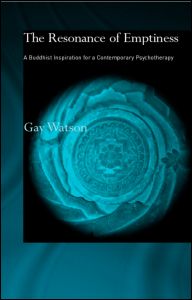
Within its genre, this book is an intellectually sophisticated and nuanced, though poorly edited attempt to effect a common law marriage between Buddhist thought and practice and contemporary Western forms of psychotherapy. I call this marriage “common law” because Watson seeks not to create a formal Buddhist-psychotherapeutic hybrid system, but rather, to create a relationship between the two that is as intimate, and yet as unbounded, as possible. The author clearly–and I think successfully–wishes not to subjugate or reduce either system to the other, but to hold the two in tensive postmodern dialogue so that the mutual “resonances” of Buddhism and psychotherapy can emerge. This dialogue remains somewhat unilateral, as throughout the author attempts to find in Buddhism points that can inspire a more efficient and profound notion of the project of Western psychotherapy while largely ignoring reverse commentary. In this effort Watson draws on a wide variety of resources, including clinical, cognitive, and neuroscience psychological literature; primary texts in translation, and scholarly secondary texts on Buddhist philosophy and practice; and postmodern philosophical and social critical works, such as those of Levinas, Bakhtin, Derrida, and Rorty.
This book pursues a unique focus on the healer rather than the healed. In Buddhism Watson finds an abundance of tools that therapists might employ to create a more efficient, deeply healing, and meaning-enhancing form of therapeutic practice. This therapist-centered orientation is a welcome departure from and supplement to other works of this genre, which typically focus on Buddhism’s power to heal from a client-centered perspective without recourse to the opportunities that Buddhism might provide to healers working their trade. Within this approach Watson exhibits a number of instructive points concerning the role of meditation, especially of the vipassanaa variety, to enhance Rogerian “congruence” or Freudian “evenly hovering attention” on the part of the healer; to enhance self-acceptance and “enactive embedded experience” on the part of the client; and to create rapport and deep communication in the therapeutic relationship itself (p. 155, 159, 164). She also finds in Buddhism a positive, nondidactic inspiration to infuse the therapeutic process with a currently lacking ethical horizon. She rightly indicates that, outside of the immediate therapist-client relationship, Western therapies falsely tend to see the client as existing in a value-free universe, a view that damages the client’s attempt to experience healthy interconnections with others (p. 20). Drawing from Buddhist understandings of the relationship between liberation and ethics, she lightly sketches an “ethic of responsibility” in which clients may develop ethical dimensions for living while expanding their experiential horizons and creating meaning for themselves (p. 131).
The helpful introduction to the book clearly delineates the course of her argumentation and the resources she will use. Those overburdened readers who read the introductory chapter to get a sense of the entire book will not be overly misled or disappointed, as both her strengths and weaknesses emerge immediately.
Chapter two surveys Western psychotherapeutic modalities, thematically arranged according to schools of psychoanalysis, behavioral and cognitive therapies, humanistic approaches, and transpersonal therapies. Those wishing for a compact introduction to the myriad forms of psychotherapy will find this chapter helpful and accessible.
In chapter three, Watson relates what she means by “Buddhism,” extracting from a wide variety of Buddhist texts, teachings, and practices a core “Buddhism of liberation” on which she will focus. I will discuss this problematic chapter more fully below.
The difficult problem of divergent notions of the self–accruing to West and East, to psychotherapy and Buddhism–intelligently emerges in chapter four. Watson sensitively explores the Buddhist concept of “no self” and creates a potent Archimedean point for the rest of the book with her understanding that Buddhism does not really deny a conventional self, but rather denies an independent, permanent self (p. 104). Also in illuminating fashion she indicates that, especially in postmodern literature, the West has of its own come to more Buddhist understandings of the nature of the decentered (not)self, allowing a fruitful dialogue between ancient Buddhist and contemporary Western notions of selfhood and interdependence (p. 124-126).
Chapters five and six represent the strongest chapters in the book. In these chapters Watson describes how Buddhism may give rise to a necessary and welcome ethical dimension for the psychotherapeutic client without the imposition of the values of the therapist on the client. For Watson, Buddhist-inspired psychotherapy leads clients to develop autonomously their own personal ethical senses based on therapeutic and possibly spiritual experiences. She also describes possible gains for both therapist and client arising from the practice, and not just the theory, of pratiityasamutpaada and tathaagatagarbha. These gains include the development for both parties of “enactive embedded experience,” which Watson considers a goal shared by Buddhism and psychotherapy alike (p. 159). This experience involves the embodied recognition of one’s place in a complete system of interconnections, the therapeutic realization of Indra’s net, rather than the development of narcissistic ego independence for which several forms of psychotherapy have been taken to task by therapists and social commentators alike.
Chapters seven through nine attempt to flesh out the insights inherent in chapters five and six in greater philosophical detail. Watson seems in these chapters to push the ripeness of the postmodern West for learning therapeutic lessons from her “Buddhism of liberation,” including lessons in greater interconnectedness, the affective (rather than purely intellectual) dislodging of independent subjectivity, and the productive navigation of apparent oppositions such as eternalism/nihilism, subjectivity/objectivity, and self/other. She fails to indicate substantially how Buddhism might learn from psychotherapy aside from her germane discussion regarding the need of Westerners to pay attention to personal narrative and coherence as well as transpersonal goals (p. 181-183).

For those who are new to, or without some specialization in, the dialogue between Western psychotherapy and Buddhism, this book is a treasure. Watson seeks to transcend more narrowly-focused works in the field with a synthetic, more generalist and summarizing approach, and to this end she reviews and utilizes an impressive body of literature concerning psychotherapy, Buddhism, and their interfaces. Works of this genre tend to understand Buddhism but not psychotherapy, or psychotherapy but not Buddhism, and Watson breaks this mold by striking a nice balance arising from a solid education in both sides of the equation. She does an admirable job of briefly surveying various forms of Western psychotherapy in both thought and practice, and that alone makes her book valuable as a reference resource. As well, her understanding of Buddhism is remarkably well-developed compared to works of some other psychotherapists, and although her presentation of Buddhist thought and practice is not without error, she generally presents Buddhism in a way that might not offend, and might even enlighten, many Buddhologists. This allows her to examine and sometimes truly explore seminal issues in the Buddhism-psychotherapy dialogue, such as the relation of secular psychological development and Buddhist spiritual development, points of identity and difference in approaches to the self, the nature of liberation, and the role of affect in pursuit of both healing and nirvaa.a.
While rich in resources, analytical discussions, and her original therapist-centered focus, Watson’s approach makes her book somewhat frustrating for those with a specialization in the conversation between Western psychotherapy and Buddhism. The overarching problem is that she simply takes on too much, and thus some of her subargumentation seems dispersed and superficial from a specialist’s point of view. For example, throughout chapter six she repeatedly indicates that vipassanaa-inspired insights will be adopted differently by alternative schools of psychotherapy, but then never spells out these specific connections. Certainly some realization of conditioned interdependence interacts quite differently with Winnicottian object relations therapy from with Ellis’s Rational Emotive Therapy. The tantalized specialist seeks greater specificity and depth in such arguments, which would lend lasting richness to the work. This problem of dispersion could only be alleviated if she had at first chosen one narrow and well-defined form of psychotherapy and exclusively explored it more substantially throughout her book.
Her presentation of Buddhism suffers similarly but more problematically. Rather than choosing one form of Buddhist thought and then developing coherent, contextualized, and consistent arguments within this single Buddhist paradigm, she attempts to represent all of Buddhism. She does this by eliminating “institutional Buddhism” from a “Buddhism of liberation,” which she considers to be the core of Buddhism everywhere, reflecting the influence of Stephen Batchelor and his Buddhism Without Beliefs. She understands this core “Buddhism of liberation” as the Four Noble Truths, pratiityasamutpaada, and “suunyataa, all of which she considers praxes or “ways” as well as philosophical doctrines (p. 68). This approach creates several difficulties. First, ever since the Buddha administered Refuge to his first followers, Buddhism has never existed without some kind of social and religious institutional dimension. Given this, stripping away Buddhist institutions does not return one to the original core of Buddhism, but in fact creates a brand new, historically aberrant form of Buddhism. Also, the texts she uses to construct this noninstitutional “Buddhism of liberation” were written by monks, de facto representatives of “institutional Buddhism.” Thus, extracting “core” liberating-Buddhism while ejecting institutional forms of Buddhist expression engages an illusion while it does the historical tradition a great disservice. Likewise, she creates a sometimes unedifying Buddhist philosophical and practical hodgepodge, blithely leaping from the Theravaada anatta to Madhyamaka “suunyataa, from classic vipassanaa to Tibetan visualization meditation, without respect for the deep differences in context of these and other views. She in fact often notes different contexts, but then proceeds as if these differences were inconsequential, this rather monovocal strategy appearing ironic in a work devoted to postmodern polyvocality. In banishing Buddhism’s institutional dimensions, she really offers only her own personal reformulation of Buddhism, and if one disagrees with her idiosyncratic reformulation, some of her subarguments evaporate or fail to persuade.
Despite these problems, The Resonance of Emptiness–because of its nuances and originality–represents an essential resource for anyone concerned with the conversation between Buddhism and psychotherapy. Its notion of “enactive embedded experience” embodies an important new understanding of the intersections of the two systems. The concepts of the injection of new ethical dimensions into the therapeutic process and the interactions between vipassanaa-inspired insights and specific schools of therapy lend fertile ground for immediate scholarly exploration. The therapist-centered orientation can provide healers with immediate tools while it adds an essential domain to the Buddhism-psychotherapy conversation that future researchers doubtlessly will extend and enrich. And the emphasis on dialogue between the two systems, rather than the creation of a new hybrid system, can serve as a useful model for these investigations. No one interested in Buddhism-inspired psychotherapy will wish to miss this work.
Source:JOURNAL OF BUDDHIST ETHICS




